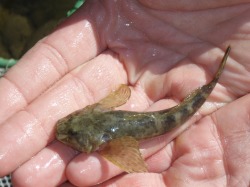Is Hang Height Important?
Our regression
analysis indicates that hang height is not an extremely strong
predictor of both strong and weak swimming stream fish catch rates.
Although Park et al. 2008 described hanging culverts as the primary
cause that may impede fish passage, in our study it appears that other
factors need to be taken into account. For instance, in addition to
hang height, Robison et al. 1999 cited high water velocities,
inadequate water depth, turbulence and debris accumulation within the
culvert may also impede fish movements. Future analyses will take
these, and habitat influences into account.
Culverts A-OK For Fish?
In our study, bridges were used as a
control to culvert stream crossings as the have been shown to be
ecologically benign crossing structures that allow fish movements
similar to natural reaches (Warren and Pardew 1998). At bridge
crossings we found that there was no difference in downstream and
upstream catch rates for strong swimming fish species, there was,
however, a significant difference for weak swimming fish species. We
suggest that the several catch rate outliers that are present among the
weak swimming families at bridges may have skewed the results, as there
was indeed a significant difference in catch rates between bridges and
culverts with a hang height. Bridges are likely still a valid control
to culvert crossings, however future sample sizes of this study should
be increased.
Pipe culvert structures are known to
decrease overall fish movements in reaches and in many cases may be
bidirectional barriers to stream fish passage (Warren and Pardew 1998,
Poplar-Jeffers 2005). From the results of the multifactor ANOVA, it
appears that at culverts with no hang height, both weak and strong
swimming fish species can navigate across the crossing structure, as
there was no significant difference in downstream and upstream catch
rates. In addition, culverts with a hang height do not appear to
restrict the movements of weak swimming fish species. Our results
contradict our original hypothesis and findings of previous researchers
who have found that culverts that are a physical barrier (have a hang
height) act as barriers to fish movements (Warren and Pardew 1998,
Poplar-Jeffers 2005, Park et al. 2008). Conversely, there was a
significant difference among the two catch rates for the strong
swimming salmonids. When culvert has a hang height, salmonids appear to
prefer the upstream habitat. Although our results appear
counterintuitive, Warren and Pardew (1998) found higher upstream small
stream fish presence of and suggested that upstream habitat may
act as a hydraulic refuge for these fish.
Management Implications

For stream fish communities, the ability to disperse is of critical importance to their persistence (Jungwirth et al.
2000). Although movement scales and patterns vary among different fish
species, in general on a small scale, dispersal allows them to seek
refuge, minimize competition, and access feeding habitats. On a larger
scale, movements allow access to spawning habitats and help maintain
genetic variability within a population. Fragmentation of streams may
cause declines in fish populations by reducing dispersal behaviour,
which in turn can alter population dynamics, and cause ecosystem-level
changes (Poplar-Jeffers 2005, Wofford et al. 2005, Park et al.
2008). The loss of this critical stream habitat may result in immediate
effects for some fish species, for others, the adverse effects may be
gradual as habitat suitability is altered over time. The result may be
fish populations that will become smaller and more vulnerable to
genetic changes or local extinctions with the increased loss and
fragmentation of habitat (Park et al. 2008). While the
full ecological effects caused by anthropogenic barriers are not
entirely understood, the number of potential barriers to fish migration
raises important questions regarding the cumulative impacts of road
crossings on fish population persistence.


